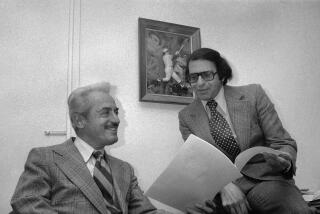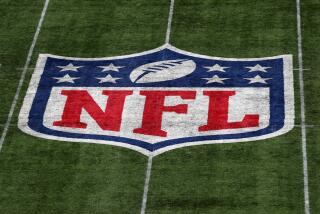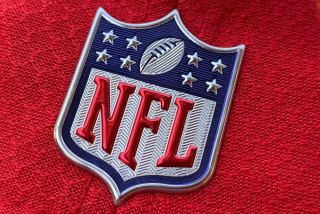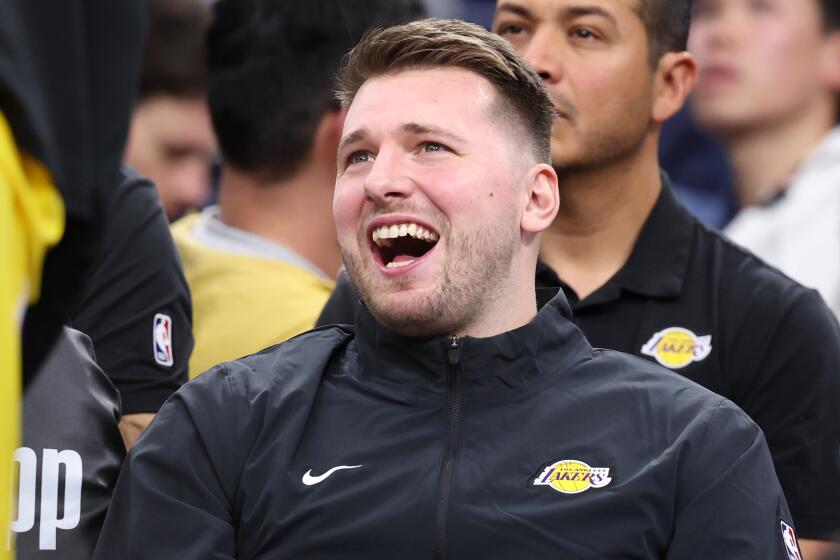Scrimmage on NFL Free Agency
- Share via
It may be hard for some to understand how such angry arguments can arise between 1,500 rich, young professional football players and a few dozen richer, older club owners--six of whom are billionaires--when the clubs’ revenue from television alone will soar 85% this year.
It would seem they would be laughing all the way to the bank, or wherever they stash their money, since their TV income will be a record $3.6 billion over the next four years.
Their arguments may seem to be energy misspent, but they are not unusual. Other wealthy people fight over money too.
It is harder, though, to understand the ludicrous way that players and owners have reversed roles as they battle in and out of the courts.
A look at the topsy-turvy world of professional football shows how this mess developed.
It is quite a twist for the National Football League to be pressing hard for a court order to make the NFL Players Assn. admit that it is a real union and that it acts like one by demanding that the owners pay players more money.
The other day, Jack Donlan, chief negotiator for the owners, tried in vain to tempt the players with this extraordinary observation:
“Let’s face it. We (management) have a lot of money. We have had a lot of committee meetings to discuss how far we can go. A ballpark figure is, we could double the benefits.”
Equally unprecedented in the world of labor-management relations is the odd posture of the players association. Although the association never before objected to being called a union, it is now fighting in court to prove that it is not legally a union and therefore cannot be forced to demand anything from the owners.
Gene Upshaw, head of the players association, wasn’t kidding a while back when he left a luncheon with this startling remark: “Well, I’ve got a union to break.” He was referring to his own.
The strange behavior by both sides stems from the impact of federal antitrust laws on the real issue in dispute: the seemingly perpetual argument over the free-agency question.
The players want to be free agents, which means that they want to be allowed to sell their talents to the highest bidder in the league. That isn’t asking too much in our free market system. They also want a union to negotiate their minimum salaries and other benefits.
For more than 20 years, the association and management fought constantly. Contract negotiations ended in strikes or lockouts five times without resolving the free-agency issue.
Under the current system, the owners have agreed to let each team “protect” 37 players--generally their best ones--from free-agency status. The remaining players have limited freedom to put their talents up for competitive bidding. The “protected” players remain captives of their team unless the owner chooses to trade or release them.
The owners still act as though they own the players, who, after some strikes, won only limited freedom to put their services up for competitive bidding among the 28 teams. To resolve the dispute without more picket lines, the association went to court asking that its members be allowed to sue the owners under federal antitrust laws.
The association contends that the owners are violating antitrust laws by conspiring among themselves to refuse to bid against one another for the talents of individual players, except when the owners agree that they are ready to bid. That amounts to an illegal attempt by the owners to fix wages, the association argues.
In the early part of this century, workers and their unions were dragged to court when they collectively demanded pay raises. They were accused of violating antitrust laws by “conspiring” among themselves to try to fix their wages.
But in the 1930s under new antitrust laws, the Supreme Court decided that workers have a right to try to “fix” their wages--if they do it collectively through a union.
Now NFL owners say players cannot sue under antitrust laws to become free agents because the law says players and owners are exempt from those laws as long as they have a collective bargaining relationship. In other words, the owners are trying to restrain players’ salaries by using the law that was developed to protect workers’ rights to raise their wages.
To defeat the owners’ slick legal trick, the union tried one of its own. It declared that it is not a union and no longer has any collective bargaining relationship with the owners. Since it has no union contract, the association says, players can sue the owners, who refuse to bid competitively for the players’ services.
There are three cases before the courts, including one before the Supreme Court, that might untangle the legal mix-up that many people see as a rich men’s squabble in which both sides are at fault. But it is a mistake to denounce both sides equally in their strange labor war.
Remember, while the players are paid well--the average annual salary is $301,000--so are other popular entertainers whose careers can go on for years. The average professional life of the players is 3.2 years, and they are frequently injured.
The owners’ careers, by contrast, are measured in decades, and the physical risk is mainly to their nervous systems as they fret over money.
The owners don’t fret, though, about competition from rival football leagues. There is none in what has been accurately called their corporate socialist monopoly: The 28 teams in the country’s only league divide 95% of all their income equally.
The players, while handsomely rewarded as entertainers, are in competition with one another for their handsome salaries.
The good news for the fans in all this is that the squabbling over money is now in the courts, not on picket lines, and training camps will open next month in time to begin the regular football season.
More to Read
Go beyond the scoreboard
Get the latest on L.A.'s teams in the daily Sports Report newsletter.
You may occasionally receive promotional content from the Los Angeles Times.










